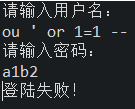PreparedStatement有效防止注入的简单示例(源码在后面):
(statement实现简单注入在上一篇博客)
程序截图:
图一 登录成功

图二 登录失败

图三 SQL简单注入失效

图四 数据库表截图

程序源码:
package sqlzhuru;
import java.sql.Connection;
import java.sql.DriverManager;
import java.sql.PreparedStatement;
import java.sql.ResultSet;
import java.sql.SQLException;
import java.util.Scanner;
public class preparedstatement {
public static void query() {
Connection conn=null;
PreparedStatement pstmt=null;
ResultSet rs=null;
try {
String URL="jdbc:mysql://localhost:3306/xuexi";
String name="root";
String pwd="YES";
Class.forName("com.mysql.jdbc.Driver");
conn=DriverManager.getConnection(URL, name, pwd);
String sql="select count(*) from login where uname=? and upwd=?";
Scanner input =new Scanner(System.in);
System.out.println("请输入用户名:");
String uname=input.nextLine();
System.out.println("请输入密码:");
String upwd=input.nextLine();
pstmt=conn.prepareStatement(sql);
pstmt.setString(1, uname);
pstmt.setString(2, upwd);
rs=pstmt.executeQuery();
int count=-1;
if(rs.next()) {
count=rs.getInt(1);
}
if(count>0) {
System.out.println("登录成功!");
}else {
System.out.println("登陆失败!");
}
}catch(ClassNotFoundException e) {
e.printStackTrace();
}catch(SQLException e){
e.printStackTrace();
}
finally {
if(rs!=null) {
try {rs.close();
}catch(SQLException e) {
e.printStackTrace();
}
}
if(pstmt!=null) {
try {
pstmt.close();
}catch(SQLException e) {
e.printStackTrace();
}
}
if(conn!=null) {
try {
pstmt.close();
}catch(SQLException e) {
e.printStackTrace();
}
}
}
}
public static void main(String[] args) {
// TODO Auto-generated method stub
query();
}
}